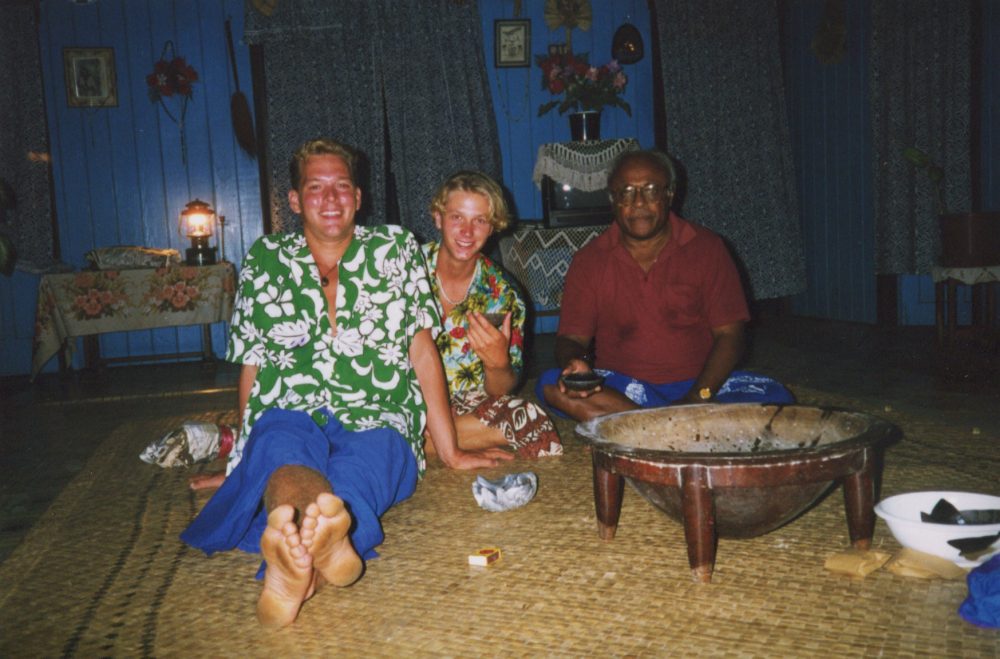November 1997: In my earliest travels, Fiji was my introduction to the Pacific Islands. As part of my round-trip airline ticket to Australia, I had one free stopover in a Pacific Island, and I chose Fiji because it was a name that conjured up images of a tropical South pacific island paradise to me. I knew nothing about it and armed only with a Lonely Planet guide that I had found somewhere in Australia, my friend Dan and I flew from Australia to Nadi, Fiji to begin a month-long backpacking trip to places in Fiji that were off the tourist trail or existed before the arrival of Fiji mass tourism.
About Fiji
Here are some facts about Fiji:
- Melanesian Island archipelago
- Ex-British colony that is English speaking
- During the colonia days, the British imported indentured labor from India and 34% of the population in Fiji remains Indian.
- 86 percent of the land in Fiji is owned by indigenous Fijians and not Indians.
- Despite the lack of land ownership, the majority of businesses in Fiji are run by Fijian Indians.
- There have been 4 coups d’état’s in Fiji’s government in the last 40 years.
- Fiji is the most visited Pacific Island nations.
- Kava, a drink made of the ground up kava root, is a traditional drink of Fiji that causes a mild narcotic effect. The importation of Kava into the USA is banned.
Route Across Fiji

Our Fiji route
Over the course of one month, Dan and I traveled across the islands Viti levu, an outer island, Vanua Levu, and Taveuni. When we first arrived in Nadi, we had a guidebook and no plan. We would end up befriending our taxi driver from the airport, a Fijian Indian man named Ram. Ram would take us to stay at his house, his wife would cook dinner for us and he would take us to play snooker at local Indian hangouts in Nadi. Nadi, a dry and not so scenic part of Fiji was not where we planned to remain, so we decided to stay in one of the outer islands with white sand beaches and coral reef that we imagined finding in Fiji. From Nadi, Ram drove us to the northeastern Viti Levu to a village where we boarded a small open top boat to an outer island where dan and I stayed in rustic bungalows operated by Fijians. The island was the paradise we hoped to find and we spent our days exploring the beaches and nights drinking kava with the Fijians.

Idyllic beaches of the island we stayed at

Stranded on a remote beach by high tide, Me in background and Dan front left along with another traveler decided to spend our time waiting out the tide making hats from the palm trees, which we would wear for the remainder of our trip.
Vanua Levu Island
Dan and I felt that the further we traveled into Fiji, the more interesting and idyllic it would become so we continued on by public ferry to the island of Vanua Levu, which receives far fewer tourists than Viti Levu. We took a bus from the ferry port to the dusty and impoverished town of Labasa, heart of sugarcane country, where we stayed a few nights. Labasa lacked any appeal, and we quickly decided it was time to move on. From Labasa we traveled by bus to the small coastal town of Savu Savu. Savu Savu located on the southern shores of Vanua Levu surrounded by lush tropical and mangrove forest. The town with decaying wooden storefronts, and rowdy bars, many with no electricity felt like a pirate town to me. The town was gritty and raw and was exciting to us. We spent a few days in Savu Savu meeting the locals and we befriended a missionary who introduced his to his family and at a barbershop, I met a Fijian man, named George getting his hair cut next to me, who was starting his own eco lodge deep in the rainforest. He was living in New Zealand and received word that he inherited a large tract of wild ancestral land in the rainforest. He was on his way to explore his land when he invited Dan and I to go with him to camp in the jungle for a few days. There was nothing built at the time, but he promised adventure hiking through the many jungles to waterfalls and rafting on the river that runs adjacent to his land. Dan and I took him up on this offer.

Me with a Fijian family I became friends with
Camping in the Rain Forest on the land of a Fijian Man I Met at the Barbershop
We hired a truck taxi and stood in the back of the truck as we traveled approx. 6 hours along a coastal dirt road that required 4 by 4 on a few occasions. The southern section of the island was hilly containing thick rainforest and there were few villages and there was lots of evidence of logging. We would end up camping along the edge of a river in the rainforest of the ancestral land belonging to George. George led us to waterfalls, and we rafted down the river on traditional billy billy rafts. During this time in my travels, I was poor at documenting the locations I visited, and I am not sure exactly what river we camped on, but I do know that in my month of travels in Fiji, this was the wildest part of the country we visited. The whole region was uninhabited, steeped in folklore about black magic and cannibal tribes and much of the rain forest remained old growth. I loved every second of the adventure.

Dan and I exploring George’s land via a small raft

Me on a billy billy raft
Taveuni Island
After a few days on George’s land, Dan and I hitchhiked back to Savu Savu from the road on top of a truck. From Savu Savu we took a public ferry to the island of Taveuni, named the garden island for its verdant forests and lush hills. Taveuni would prove to be the highlight of our trip to Fiji, and we stayed for a week in a basic bungalow on the island’s southern shores. From there we explored the island’s many hiking trails and spend countless hours swimming in waterfalls with local kids. Taveuni is my kind of island. It is largely undeveloped, and its core consists of dormant volcanos, and jungles and there are few roads, and the entire southern section of the island is protected without any roads at all. Taveuni is also known as one of the only islands in the world where the international dateline passes, and you can stand one foot in the past and one in the future or urinate as we did into the past or future.

Dan and I walking along a beach trail -Lavena Coastal Walk through remote thatched roof villages to remote jungle waterfalls

Remote thatched roof village

Jungle waterfall that could only be reached by swimming through this canyon. We took turns sliding down a natural waterslide into the cool pool of water below it.

Swimming in one of the waterfalls of Taveuni

Dan and I swimming with village kids at Bouma Falls
Climbing a Dormant Volcano into a Quicksand Swamp with Village Children Guides
One day i decided to do something hard and challenging and Dan decided he would stay back in the bungalow so i went alone. I was going to hike 6-7 hours to the top of a dormant volcano 3000 feet tall through challenging rainforest terrain to a swamp in the volcanic crater. I hitchhiked to a village at the base of the volcano and asked around the village for a guide to lead me to the volcano and the only available guides were three small barefoot village boys. They led me through humid jungle, stopping occasionally to stare in awe at luxurious feathered parrots until we eventually reached the cloudy summit of the volcano where we reached a mysterious crater lake. For some reason i decided I wanted to explore further into the lake which looked more like a swamp and the boys warned me that I would need a large stick first and I would have to test the ground before each step to make sure I didn’t sink into quicksand. They warned me that a few people including tourists have disappeared into the lake’s quicksand. I quickly discovered what they meant by this. I took one wrong step and instantly plunged up to my waist in mud when one of the boys lurched for me with his stick allowing me to grab it so that I wouldn’t sink any further. The three boys pulled me out of the mud, which I also learned was quicksand and deadly. Without learning my lesson, I continued on, and the boys lead me further into the swamp and we hiked until we reached a beautiful display of colorful flowers growing out of the mud that I would later learn was the famous Tagimaucia flower, which according to legend was named after a village girl forbidden by her father to marry the boy she loved. I decided to take one flower and bring it home for my mom. I would later discover the truth about another legend; the flower cannot be removed from the lake because if it is its beauty will fade and the flower will wilt. By the time I left the volcano I discovered my flower had all but almost vanished.

My village kid guides

Hiking to the Volcano crater lake

Crater lake on top of the volcano where I found the sacred flower
Meeting a Village Chief and Drinking Kava Together
I really wanted to meet one of the Fijian chiefs and one day I asked the gardener working at my guesthouse how I could do such a thing and he advised me to go to a local market and purchased some kava roots first because it was tradition to present kava roots to a Fijian chief when meeting them as a sign of respect. The gardener then informed me he would ask the chief of his village if he was open to the idea of meeting Dan and I. I later learned that he would be delighted to meet us, and I purchased kava roots from a nearby market and together with the gardener Dan and I visited the Fijian chief one night. It was an interesting experience, and the wife of the man prepared the kava drink for us and poured it into a large wooden bowl at the center of the chief’s house. Together the chief, the gardener, Dan and I sat on the floor taking turns sipping kava from small wooden cups via the traditional kava ceremony that involved a lot of clapping and repeating the words Bula-Fijian greeting word. The women of the village were not allowed to partake in the ceremony and instead prepared the drink for us. The Kava left us feeling lazy and relaxed with a tingle like sensation on our lips and tongues. The taste of kava resembled soapy water and was not appealing but we had a great time sitting with the chief exchanging stories about Minnesota and our lives with him.

Dan and I wearing the traditional Fijian skirt and colorful shirts seated next to the village chief and his kava bowl in his house

Villagers at the kava ceremony we had with the village chief. The chiefs wife, who prepared our drink is seated to the left and Dan to the right. The others in the photo are villagers.
From Taveuni, Dan and I flew back to Nadi and spent a few days surfing a black volcanic sand beach and staying in a guesthouse outside of Nadi before returning back to Minnesota.

